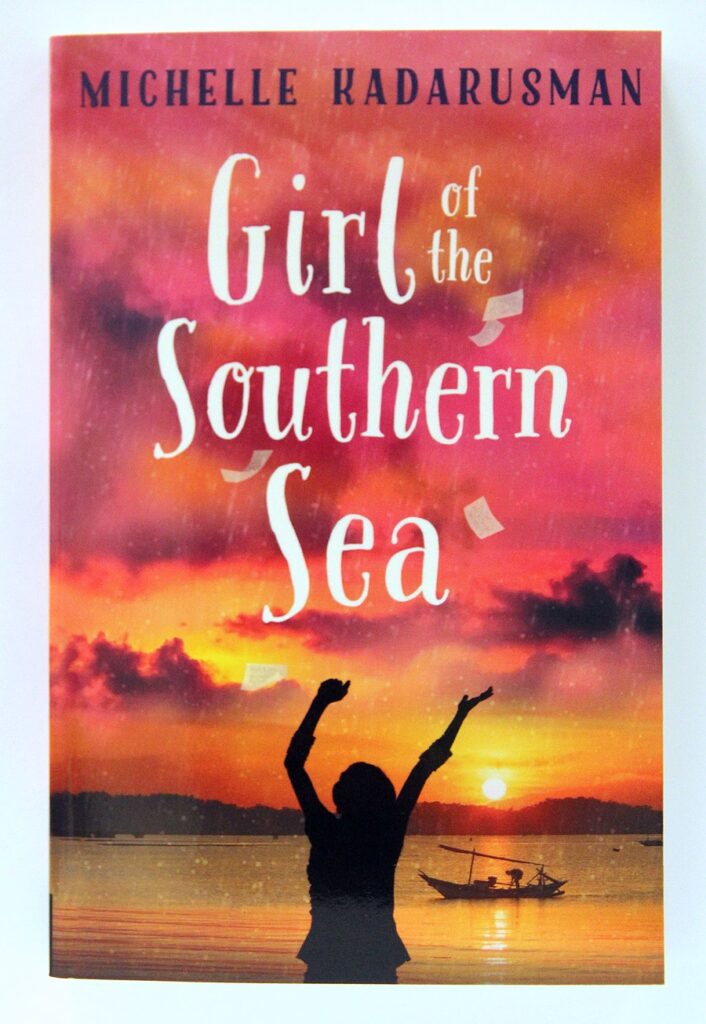
Title: Girl of the Southern Sea
Author: Michelle Kadarusman
Publisher: University of Queensland Press – UQP
Publication date: February 2, 2021
Themes: courage, family, friendship, loss, poverty, the power of story, Javanese folktale, hope, education, Indonesia
Additional notable information: Teacher notes can be downloaded from the UQP website.
Girl of the Southern Sea by Michelle Kadarusman is a tale of love, loss, courage, the power of storytelling and hope for a better future driven by one girl’s indomitable spirit.
Nia, a young teenage girl, lives with her Bapak (father) and younger brother, Rudi, in the impoverished slums in Jakarta. Rudi’s birth led to their mother’s death and their father has never forgiven Rudi for this. He spends his days drinking Arak, an alcoholic spirit and frivolously spends their already meagre income that he and Nia earn selling fried bananas at the market. Nia, wise beyond her years, dutifully takes on all responsibilities and arduous jobs associated with looking after their home and family. She selflessly mothers Rudi, shielding him from the full extent of their father’s behaviour. Nia desperately wants to continue her education and pursue her dream of becoming a writer, but her father is unable to afford the school fees. Instead, Nia spends her days collecting water from the communal tap each morning for them to drink and clean with, cooking the meals, preparing the batter for her father to use at the market, taking Rudi to and from school and helping her father sell the fried bananas while Rudi is at school.
Writing is a cathartic experience for Nia and she escapes her cruel life momentarily through storytelling. One significant story to Nia is the story of Dewi Kadita, a mythological goddess from an ancient Javanese folktale, known by many names in the different retellings of the story, one being Queen of the Southern Sea. This story is special to Nia as it was her favourite story her mother used to tell her. Nia uses the character of Dewi Kadita as a source of inspiration for her own writing. Her mother suggested to her that she could write her own version of the story where the girl overcomes her adversity. She promised her mother she would do this. Nia keeps her promise by writing stories where Dewi Kadita not only survives but thrives, by rising to all challenges. Nia shares her engaging and sometimes humourous stories with Rudi and they are a source of comfort to them.
Nia navigates life for her family and faces unfathomable, often dangerous situations and in each of these instances shows such tenacity and fierce determination. She survives a minibus accident and this is seen as a miraculous escape. A self-serving local, Oskar, witnesses the accident and declares Nia has good luck magic. This spreads rapidly amongst the locals. Oskar sees this as an opportunity for Nia to sell her fritters at an inflated price. In the short term there is a high demand for Nia’s fritters, but eventually customers see that they are not experiencing the good luck magic and they turn on her in a most brutal way. Nia lives with no choice but to constantly strive for better even when that means having the courage to use her voice to stand up to the supplier of her father’s Arak; or negotiate with a corrupt police officer to secure release for her father from prison; reject an arranged marriage to defend her future and berate her father for his abuse of alcohol.
The inclusion of the map at the beginning of the story and the glossary at the end is very useful to refer to when reading the book to gain a greater insight into the Indonesian references. Michelle Kadarusman also includes information about the legend of Dewi Kadita and author’s note at the end of the book which enables the reader to learn more about Jakarta and the culture of Indonesia as well as her source of inspiration for this story.
From the very opening paragraph the reader cannot help but invest in Nia’s character and empathise for her as she strives with such fierce spirit for a better future. This heart touching story highlights the plight of girls (not only in Indonesia) living in impoverished conditions and ultimately tells the story of a girl who not only dares to dream, but fights to create a future that goes against her societal and cultural restraints.
